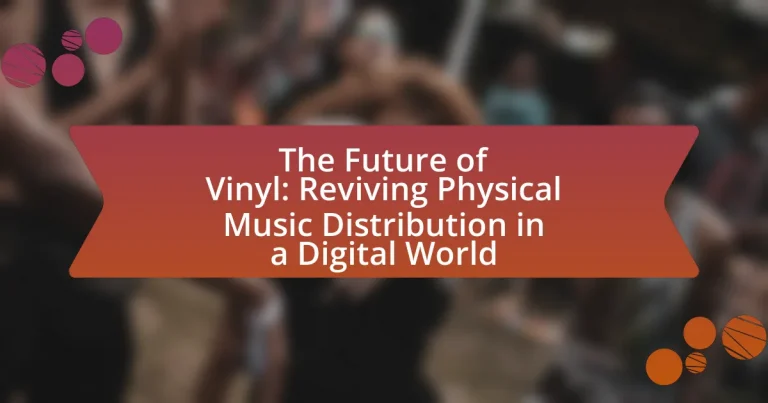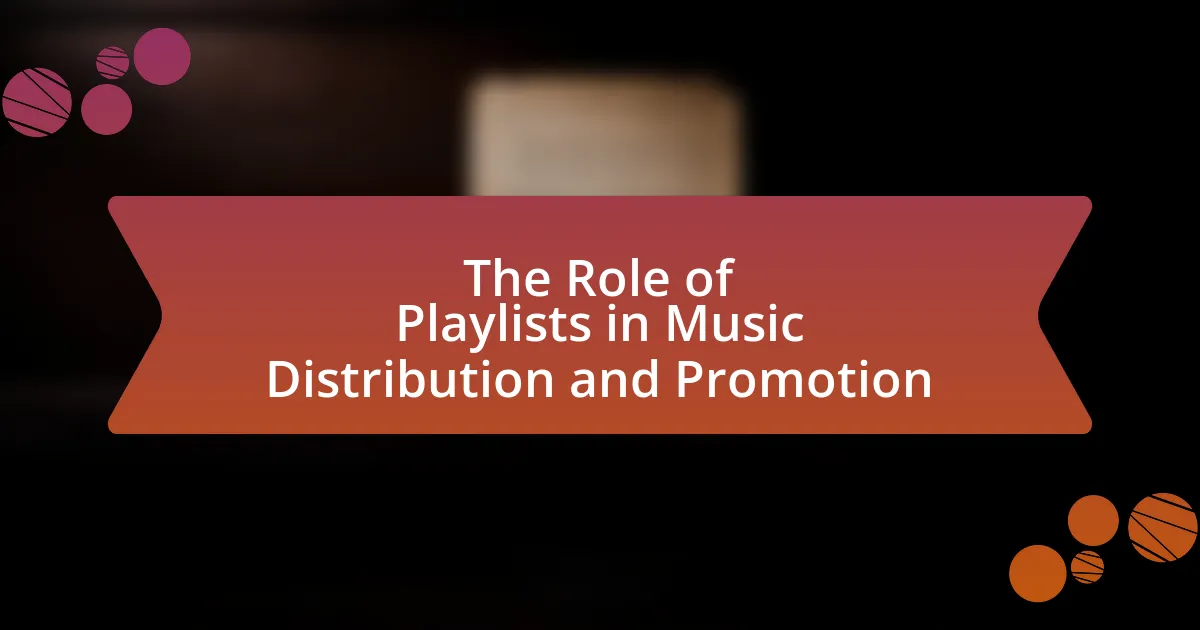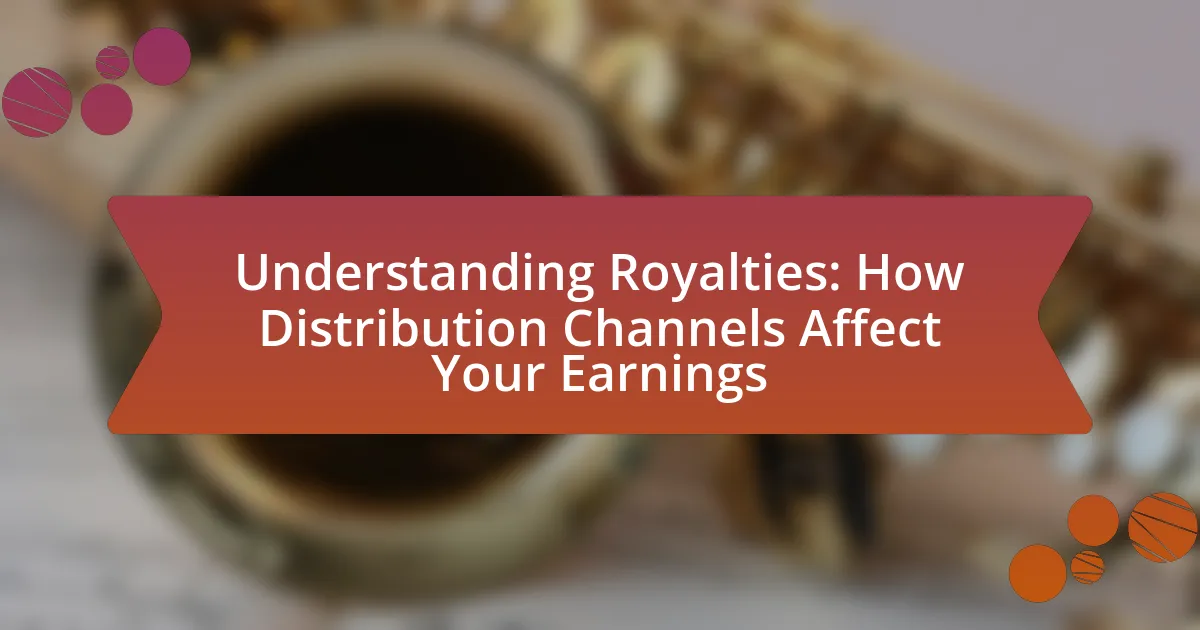The article focuses on the future of vinyl records in an increasingly digital music landscape, highlighting the significant resurgence in vinyl sales, which reached 41.7 million units in the U.S. in 2022, the highest since 1987. It examines the factors contributing to this revival, including consumer preferences for tangible music experiences, the unique sound quality of vinyl, and the emotional connections associated with physical media. The article also discusses the evolution of the vinyl industry, challenges it faces, and innovative distribution strategies being employed, such as direct-to-consumer sales and subscription services. Additionally, it explores the impact of technological advancements on vinyl production and the role of vinyl in supporting artist revenue and community engagement within the music culture.

What is the Future of Vinyl in a Digital World?
The future of vinyl in a digital world is promising, as vinyl records have experienced a significant resurgence in popularity, with sales reaching 41.7 million units in the U.S. in 2022, the highest level since 1987. This revival is driven by consumers’ desire for tangible music experiences and the unique sound quality that vinyl offers, which contrasts with the often compressed audio of digital formats. Additionally, the growth of independent record stores and vinyl pressing plants supports this trend, indicating a sustainable market for vinyl alongside digital music.
How has the vinyl industry evolved in recent years?
The vinyl industry has experienced a significant resurgence in recent years, marked by a dramatic increase in sales and production. In 2020, vinyl sales in the United States surpassed CD sales for the first time since the 1980s, with vinyl records accounting for 27.5 million units sold compared to 18.6 million CDs, according to the Recording Industry Association of America (RIAA). This revival is driven by a growing consumer preference for physical media, nostalgia, and the unique audio quality that vinyl offers. Additionally, the number of vinyl pressing plants has increased, with many new facilities opening to meet the rising demand, reflecting a broader trend of revitalizing physical music distribution in an increasingly digital landscape.
What factors have contributed to the resurgence of vinyl records?
The resurgence of vinyl records is primarily driven by a growing consumer preference for tangible music formats and the unique audio quality that vinyl offers. This trend is supported by statistics indicating that vinyl sales reached 41 million units in 2020, the highest level since 1986, according to the Recording Industry Association of America (RIAA). Additionally, the nostalgia associated with vinyl, along with the aesthetic appeal of album artwork and the experience of physically handling records, has attracted both older generations and younger listeners. The rise of independent record stores and vinyl-focused events has further fostered a community around vinyl culture, enhancing its popularity in the digital age.
How do sales figures compare between vinyl and digital formats?
Vinyl sales have seen a significant resurgence, with figures indicating that in 2022, vinyl records accounted for approximately 41 million units sold in the United States, surpassing CD sales for the first time since the 1980s. In contrast, digital music formats, including streaming services, dominate the market, generating over $13 billion in revenue in the same year, with streaming accounting for the majority of that income. This stark contrast highlights the growing popularity of vinyl as a physical format, while digital formats continue to lead in overall revenue and accessibility.
Why is vinyl experiencing a revival despite digital dominance?
Vinyl is experiencing a revival despite digital dominance due to its unique sound quality and tangible nature, which many audiophiles and collectors prefer. The analog warmth of vinyl records offers a listening experience that digital formats often cannot replicate, appealing to those seeking authenticity in music. Additionally, sales data from the Recording Industry Association of America (RIAA) indicates that vinyl sales reached 41 million units in 2020, the highest level since 1986, showcasing a significant consumer interest. This resurgence is also fueled by the growing trend of music enthusiasts valuing physical media as collectibles, further solidifying vinyl’s place in the modern music landscape.
What emotional and nostalgic connections do consumers have with vinyl?
Consumers have strong emotional and nostalgic connections with vinyl due to its tangible nature and historical significance in music culture. The physical act of handling vinyl records evokes memories of past experiences, such as listening to music with family or friends, which enhances the emotional bond. Additionally, the unique sound quality of vinyl, often described as warmer and richer than digital formats, contributes to a sense of authenticity that resonates with listeners. Research indicates that 70% of vinyl buyers cite nostalgia as a primary reason for their purchase, reflecting a desire to reconnect with the music of their youth and the era when vinyl was the dominant format. This nostalgia is further reinforced by the resurgence of vinyl in popular culture, with sales reaching a 30-year high in 2020, indicating a collective yearning for the past among consumers.
How does the tactile experience of vinyl differ from digital music?
The tactile experience of vinyl differs from digital music primarily in the physical interaction and sensory engagement it offers. Vinyl records require handling, such as placing the record on a turntable, carefully lowering the needle, and turning the disc, which creates a more immersive and intentional listening experience. In contrast, digital music is often accessed through devices with minimal physical interaction, typically involving just a click or tap. This difference in engagement is supported by studies indicating that physical formats like vinyl can enhance emotional connection and nostalgia, as the act of handling records can evoke memories and a sense of ritual that digital formats lack.
What challenges does the vinyl industry face moving forward?
The vinyl industry faces significant challenges moving forward, primarily due to supply chain issues, rising production costs, and competition from digital music formats. Supply chain disruptions have been exacerbated by global events, leading to delays in manufacturing and distribution. Additionally, the cost of raw materials, such as PVC for records, has increased, impacting profit margins for producers. Furthermore, the convenience and accessibility of digital music continue to attract consumers, posing a threat to the resurgence of vinyl. According to the Recording Industry Association of America, while vinyl sales have grown, they still represent a fraction of overall music consumption, highlighting the ongoing competition with digital platforms.
How do production and distribution issues impact vinyl availability?
Production and distribution issues significantly impact vinyl availability by creating bottlenecks that limit the supply of records. For instance, the resurgence in vinyl popularity has led to increased demand, but many pressing plants operate at capacity, resulting in longer lead times for production. According to the Record Industry Association of America, vinyl sales reached 41 million units in 2020, the highest level since the 1980s, which exacerbates these production constraints. Additionally, distribution challenges, such as shipping delays and increased freight costs, further hinder the timely delivery of vinyl records to retailers. These factors combined lead to shortages in the market, making it difficult for consumers to find desired titles.
What role does pricing play in consumer choices between vinyl and digital?
Pricing significantly influences consumer choices between vinyl and digital formats. Consumers often perceive vinyl as a premium product, leading to a willingness to pay higher prices for the tactile and nostalgic experience it offers. In contrast, digital music typically has lower price points, appealing to budget-conscious consumers seeking convenience and instant access. According to a 2021 report by the Recording Industry Association of America, vinyl sales reached $1 billion, indicating a strong market despite higher prices compared to digital downloads, which average around $1 per song. This data illustrates that while pricing is a critical factor, the perceived value of vinyl’s unique attributes can drive consumers to choose it over more affordable digital options.
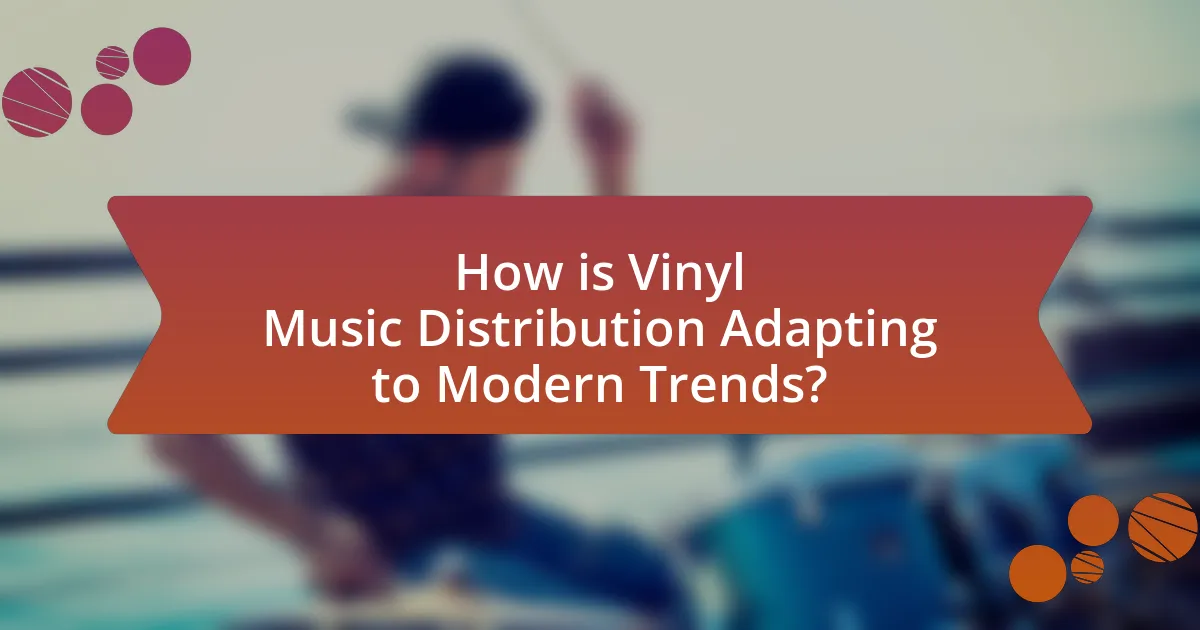
How is Vinyl Music Distribution Adapting to Modern Trends?
Vinyl music distribution is adapting to modern trends by leveraging digital platforms and e-commerce to reach a broader audience. This adaptation includes the integration of online sales channels, allowing consumers to purchase vinyl records directly from artists and labels through websites and social media. Additionally, vinyl distributors are utilizing data analytics to understand consumer preferences and optimize inventory management, which has led to a resurgence in vinyl sales; for instance, in 2020, vinyl sales in the U.S. surpassed CD sales for the first time since the 1980s, according to the Recording Industry Association of America (RIAA). Furthermore, collaborations with streaming services have enabled vinyl releases to coincide with digital album launches, enhancing visibility and accessibility for both new and classic records.
What innovative strategies are being employed in vinyl distribution?
Innovative strategies in vinyl distribution include direct-to-consumer sales, subscription services, and enhanced digital integration. Direct-to-consumer sales allow artists and labels to bypass traditional retail channels, increasing profit margins and fostering closer relationships with fans. Subscription services, such as Vinyl Me, Please, provide curated selections of vinyl records, creating a personalized experience that appeals to collectors. Enhanced digital integration involves using data analytics to understand consumer preferences and optimize inventory management, ensuring that popular titles are readily available. These strategies reflect a shift towards more personalized and efficient distribution methods in the evolving vinyl market.
How are record labels leveraging social media to promote vinyl releases?
Record labels are leveraging social media to promote vinyl releases by utilizing targeted advertising, engaging content, and influencer partnerships. Targeted advertising on platforms like Instagram and Facebook allows labels to reach specific demographics interested in vinyl, enhancing visibility and driving sales. Engaging content, such as behind-the-scenes videos, artist interviews, and unboxing experiences, fosters a connection with fans and encourages sharing. Additionally, collaborations with influencers and vinyl enthusiasts amplify reach, as these individuals often have dedicated followings that trust their recommendations. This multi-faceted approach has proven effective, as evidenced by the resurgence of vinyl sales, which reached 41 million units in 2022, the highest level since the 1980s, according to the Recording Industry Association of America.
What partnerships are emerging between vinyl manufacturers and retailers?
Emerging partnerships between vinyl manufacturers and retailers are increasingly focused on exclusive releases and collaborative marketing strategies. For instance, manufacturers like Record Store Day have partnered with independent retailers to create limited edition vinyl releases, driving both sales and foot traffic to stores. Additionally, manufacturers are collaborating with retailers to develop subscription services that deliver curated vinyl selections directly to consumers, enhancing customer engagement and loyalty. These partnerships are supported by the resurgence in vinyl sales, which reached 41 million units in 2022, indicating a strong market demand for physical music formats.
How are consumer preferences influencing vinyl distribution methods?
Consumer preferences are significantly influencing vinyl distribution methods by driving a shift towards direct-to-consumer sales and limited edition releases. As vinyl enthusiasts increasingly seek unique and personalized experiences, record labels and retailers are adapting by offering exclusive pressings and bundles that cater to this demand. For instance, a report from the Recording Industry Association of America (RIAA) indicated that vinyl sales reached a 30-year high in 2020, with consumers favoring physical formats that provide a tangible connection to music. This trend has prompted distributors to prioritize online sales platforms and social media marketing to engage directly with consumers, enhancing accessibility and convenience in purchasing vinyl records.
What trends are shaping the types of vinyl products being offered?
The trends shaping the types of vinyl products being offered include a resurgence in demand for high-quality pressings, unique artwork, and limited editions. This resurgence is driven by a growing consumer preference for tangible music formats, with sales of vinyl records reaching 41 million units in the U.S. in 2022, the highest level since 1987, according to the Recording Industry Association of America. Additionally, the rise of audiophile-grade vinyl, which emphasizes superior sound quality and meticulous production processes, reflects a trend towards premium offerings in the market. Furthermore, collaborations between artists and brands to create exclusive vinyl releases are becoming increasingly popular, catering to collectors and enhancing the overall appeal of vinyl as a collectible item.
How do subscription services impact vinyl distribution models?
Subscription services significantly alter vinyl distribution models by providing a steady revenue stream and direct access to niche markets. These services, such as Vinyl Me, Please and others, allow consumers to receive curated selections of vinyl records regularly, which enhances customer loyalty and engagement. This model contrasts with traditional retail distribution, where sales are often reliant on physical store presence and broader market appeal.
The rise of subscription services has led to increased demand for specific genres and limited editions, prompting record labels to adapt their production strategies. For instance, according to a report by the Recording Industry Association of America, vinyl sales have surged, with subscription services contributing to a 29% increase in vinyl revenue in 2020 alone. This shift indicates that subscription models not only sustain but also stimulate the vinyl market, allowing for more targeted marketing and distribution strategies that cater to dedicated vinyl enthusiasts.
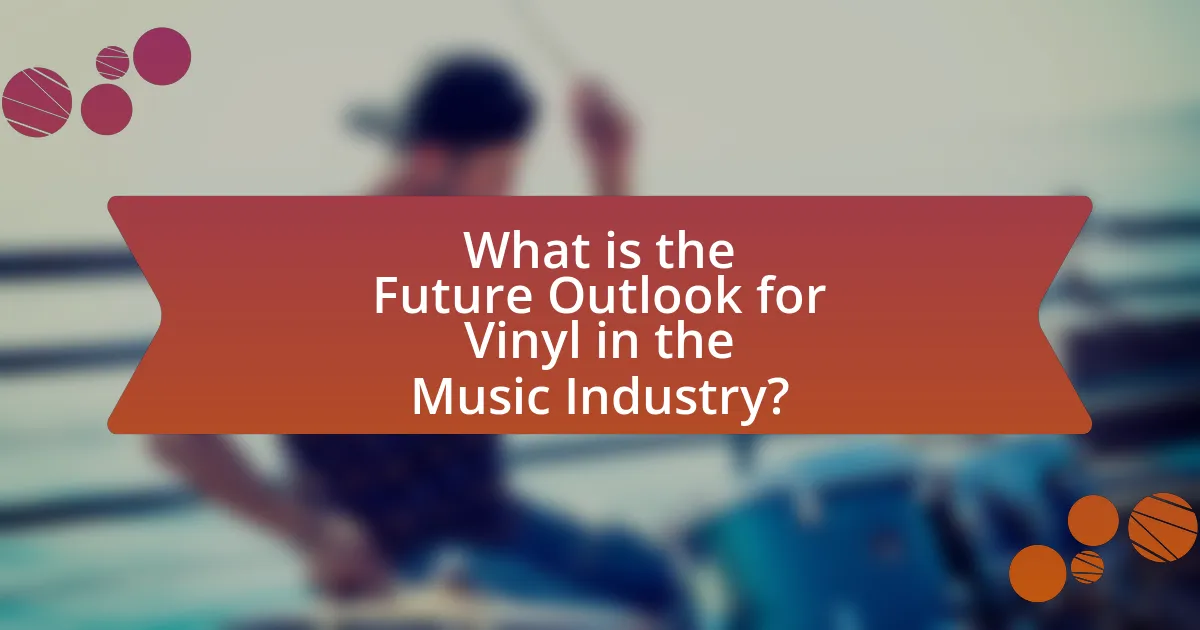
What is the Future Outlook for Vinyl in the Music Industry?
The future outlook for vinyl in the music industry is positive, with continued growth expected in sales and popularity. In 2022, vinyl sales in the United States surpassed CD sales for the first time since the 1980s, indicating a strong resurgence in consumer interest. This trend is supported by a growing appreciation for the tactile experience of physical media and the unique sound quality that vinyl offers. Additionally, the Record Industry Association of America reported that vinyl sales accounted for nearly 50% of all physical music revenue in 2021, highlighting its significant role in the market. As artists and labels increasingly release new albums on vinyl, the format is likely to maintain its relevance in an increasingly digital landscape.
How will technological advancements affect vinyl production?
Technological advancements will enhance vinyl production by improving manufacturing efficiency and sound quality. Innovations such as digital cutting technology allow for more precise groove placement, resulting in better audio fidelity. Additionally, advancements in materials, like high-quality PVC and eco-friendly alternatives, contribute to durability and sustainability in vinyl records. For instance, the introduction of 3D printing techniques in the production process can reduce waste and lower costs, making vinyl more accessible. These developments indicate a trend towards a more efficient and environmentally conscious vinyl production industry.
What innovations in sound quality are being explored for vinyl records?
Innovations in sound quality for vinyl records include advancements in cutting techniques, improved materials for vinyl pressing, and the use of high-resolution digital sources. Modern cutting techniques, such as laser cutting, allow for more precise grooves, enhancing audio fidelity. Additionally, the introduction of new vinyl formulations, like those that reduce surface noise and improve durability, contributes to a clearer sound. Research indicates that using high-resolution digital files during the mastering process can significantly enhance the dynamic range and overall quality of the final product, as evidenced by studies from the Audio Engineering Society.
How might digital technology enhance the vinyl listening experience?
Digital technology can enhance the vinyl listening experience by integrating high-resolution audio streaming and interactive features. For instance, services like Tidal and Qobuz offer lossless audio quality that can complement vinyl playback, allowing listeners to access a broader range of music with superior sound fidelity. Additionally, apps can provide detailed information about the album, such as artist interviews, track annotations, and historical context, enriching the listener’s engagement with the music. This integration of digital resources with physical media creates a more immersive and informative experience, appealing to both audiophiles and casual listeners.
What role does vinyl play in the broader music ecosystem?
Vinyl plays a significant role in the broader music ecosystem by serving as a tangible medium that enhances the listening experience and fosters a connection between artists and fans. The resurgence of vinyl sales, which reached 41 million units in the U.S. in 2020, indicates a growing consumer preference for physical formats over digital streaming. This trend not only supports independent record stores and artists but also contributes to the overall revenue of the music industry, which saw vinyl sales surpass CD sales for the first time since the 1980s. Vinyl’s unique sound quality and collectible nature appeal to audiophiles and collectors, reinforcing its importance in a predominantly digital landscape.
How does vinyl contribute to artist revenue compared to digital platforms?
Vinyl contributes significantly to artist revenue compared to digital platforms due to higher profit margins and consumer willingness to pay a premium for physical formats. For instance, artists typically earn around $5 to $10 per vinyl record sold, while digital platforms like Spotify pay artists an average of $0.003 to $0.005 per stream. This stark difference illustrates that a single vinyl sale can equate to thousands of streams on digital platforms, making vinyl a more lucrative option for artists seeking to maximize their earnings. Additionally, the resurgence of vinyl sales, which reached 41 million units in the U.S. in 2022, indicates a growing market that supports artist revenue through direct sales and merchandise bundles.
What impact does vinyl have on music culture and community engagement?
Vinyl significantly impacts music culture and community engagement by fostering a tangible connection between artists and listeners. The resurgence of vinyl records has led to increased participation in local music scenes, as independent record stores often serve as community hubs for music lovers. According to a report by the Recording Industry Association of America, vinyl sales reached 41 million units in 2020, marking the highest level since 1986, which indicates a growing interest in physical music formats. This revival not only supports artists through direct sales but also encourages live events, listening parties, and collaborations among fans, thereby strengthening community ties.
What practical tips can consumers consider when purchasing vinyl?
When purchasing vinyl, consumers should consider checking the condition of the record, as this significantly affects sound quality and longevity. Inspecting for scratches, warps, and dirt can help ensure a better listening experience. Additionally, consumers should verify the pressing quality, as records pressed on heavier vinyl (180g or more) tend to be more durable and produce better sound. Researching the label and artist can also provide insights into the quality of the release, as reputable labels often maintain higher production standards. Finally, consumers should consider purchasing from trusted retailers or directly from artists to avoid counterfeit products, which can be prevalent in the vinyl market.
How can consumers identify quality vinyl records?
Consumers can identify quality vinyl records by examining several key factors, including the pressing quality, the condition of the vinyl, and the reputation of the label. High-quality vinyl records are typically pressed on heavier, thicker vinyl, which reduces surface noise and enhances sound quality. Additionally, consumers should inspect the record for any visible scratches, warps, or dust, as these imperfections can affect playback. The label’s reputation also plays a crucial role; established labels known for their quality control, such as MoFi or Analogue Productions, often produce superior records. Furthermore, reviews and ratings from other collectors can provide insights into the quality of specific pressings.
What are the best practices for caring for vinyl collections?
The best practices for caring for vinyl collections include proper storage, regular cleaning, and careful handling. Storing vinyl records vertically in a cool, dry environment prevents warping and damage. Cleaning records with a carbon fiber brush before each play removes dust and debris, while using a record cleaning solution and microfiber cloth for deeper cleaning maintains sound quality. Additionally, handling records by the edges minimizes fingerprints and oils from hands, preserving the integrity of the grooves. These practices are essential for maintaining the longevity and sound quality of vinyl records, as improper care can lead to irreversible damage and degradation of audio fidelity.
